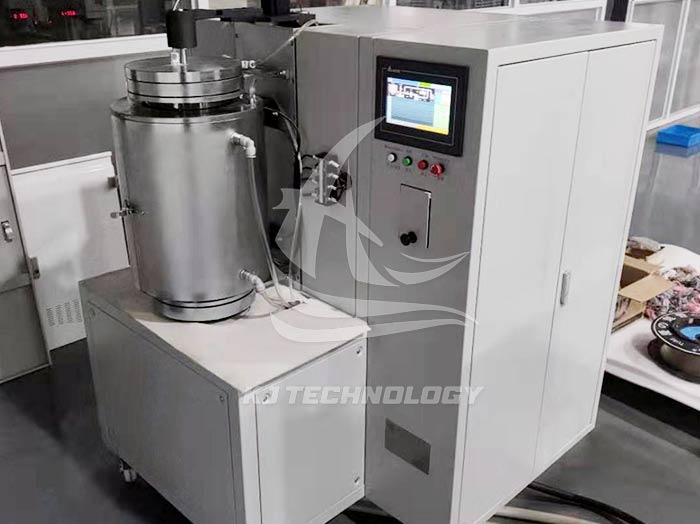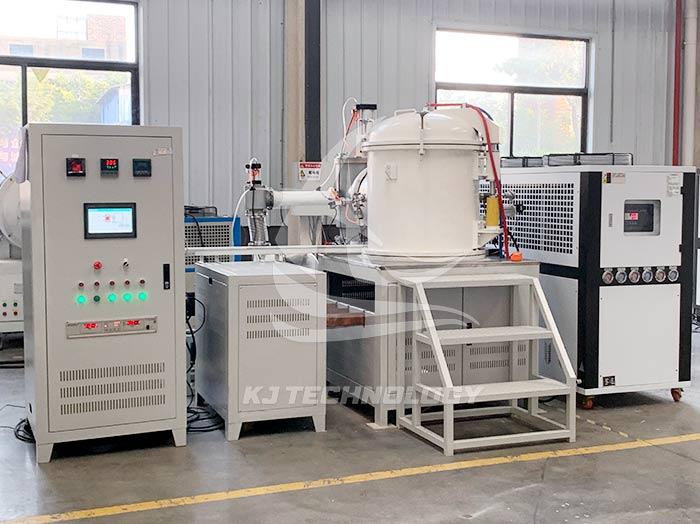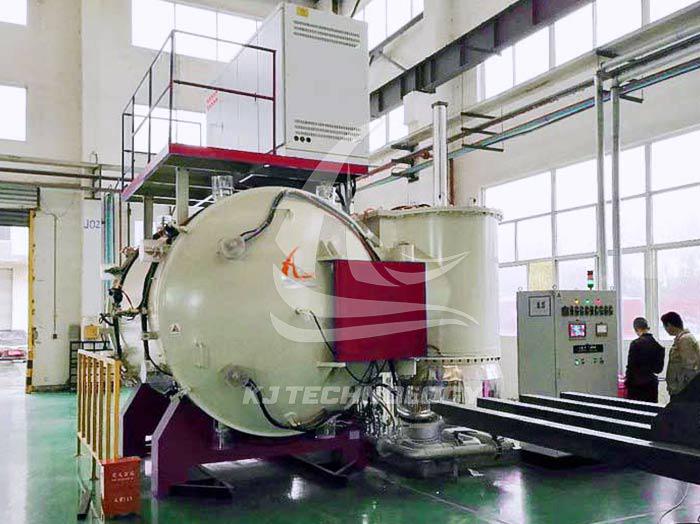What processes can large-sized furnace vacuum heat treatment furnaces be used for?
 09-29-2025 Author: KJ technology
09-29-2025 Author: KJ technology
Large scale furnace vacuum heat treatment furnaces, with their vacuum environment, large processing capacity, and high-precision control, can be widely used in various heat treatment processes to meet the needs of different materials and workpieces. The following are its main process types and specific application scenarios:
1. Quenching process
Vacuum oil quenching
Applicable materials: medium high carbon steel, alloy steel (such as 42CrMo, 9CrSi).
Process characteristics: After heating the workpiece to austenitization temperature in a vacuum environment, it is quickly immersed in vacuum oil for cooling, forming a martensitic structure and improving hardness and wear resistance.
Advantages: Avoiding oxidation and decarburization, uniform quenching layer, and small deformation.
Application scenario: Heat treatment of automotive gears and mold steel parts.
Vacuum high-pressure gas quenching
Applicable materials: high-speed steel, tool steel, stainless steel (such as H13, M2).
Process characteristics: Through high-pressure nitrogen (or helium) forced cooling, the cooling rate can reach over 50 ℃/min, forming a fine martensitic structure.
Advantages: No oil pollution, high surface smoothness of workpieces, suitable for precision parts.
Application scenario: Heat treatment of aircraft engine blades and cutting tools.
Vacuum salt quenching
Applicable materials: low-alloy steel, carbon steel.
Process features: After vacuum heating, the workpiece is immersed in molten nitrate (such as KNO3+NaNO ₂) for cooling, achieving isothermal quenching or graded quenching.
Advantages: Low quenching stress and low workpiece deformation.
Application scenarios: Heat treatment of complex shaped molds and shaft components.
2. Annealing process
Vacuum complete annealing
Applicable materials: medium high carbon steel, alloy steel (such as 45 # steel, Cr12MoV).
Process features: Heat the workpiece to 30-50 ℃ above Ac ∝, keep it warm, and slowly cool it to below 600 ℃ before removing it from the furnace to eliminate internal stress and reduce hardness.
Advantages: Avoid oxidation and decarburization, and achieve uniform annealing structure.
Application scenario: Softening treatment of forged workpieces to prepare for subsequent processing.
Vacuum spheroidization annealing
Applicable materials: high carbon steel (such as T10A, GCr15).
Process characteristics: Heat to 20-30 ℃ above Ac ₁, keep warm, and slowly cool to below Ar ₁ to spheroidize carbides and improve cutting performance.
Advantages: Uniform spheroidized structure, reducing tool wear and tear.
Application scenario: Heat treatment of bearing steel and tool steel.
Vacuum stress relief annealing
Applicable materials: welded parts, cast parts, cold worked parts.
Process features: Heat to 500-650 ℃, maintain insulation, and slowly cool to eliminate residual stress.
Advantages: Avoid oxidation and prevent stress corrosion cracking.
Application scenarios: Heat treatment of large framework structures and pressure vessels.
3. Tempering process
Vacuum low-temperature tempering
Applicable materials: quenched high-speed steel, tool steel (such as W18Cr4V).
Process features: Heating to 150-250 ℃, cooling after insulation, eliminating quenching stress, and improving toughness.
Advantages: Avoid oxidation and maintain surface hardness.
Application scenario: Final heat treatment of cutting tools and molds.
Vacuum medium temperature tempering
Applicable materials: spring steel, bearing steel (such as 60Si2Mn, GCr15).
Process features: Heating to 350-500 ℃, insulation and cooling to obtain tempered martensite structure and improve elastic limit.
Advantages: Uniform tempering structure and stable performance.
Application scenario: Heat treatment of automotive suspension springs and bearings.
Vacuum high-temperature tempering
Applicable materials: quenched and tempered steel (such as 40Cr, 42CrMo).
Process features: Heating to 500-650 ℃, holding and cooling to obtain tempered martensite structure, improving comprehensive mechanical properties.
Advantages: Avoid oxidation and maintain surface smoothness.
Application scenario: Heat treatment of shaft and gear components.
4. Chemical heat treatment process
Vacuum carburizing
Applicable materials: low carbon steel, low alloy steel (such as 20CrMnTi, 16Mn).
Process features: Propane, acetylene and other hydrocarbons are introduced in a vacuum environment, heated to 900-950 ℃ to achieve surface carburizing and form a high carbon martensitic layer.
Advantages: Uniform infiltration layer, no internal oxidation, and faster carburizing speed than gas carburizing.
Application scenario: Surface strengthening of automotive gears and shaft components.
Vacuum nitriding
Applicable materials: alloy steel, stainless steel (such as 38CrMoAl, 1Cr18Ni9Ti).
Process characteristics: Ammonia or nitrogen gas is introduced in a vacuum environment and heated to 500-580 ℃ to form a nitride layer (such as Fe ∝ N, Fe ₄ N), which improves surface hardness and wear resistance.
Advantages: The nitride layer is dense and has good corrosion resistance.
Application scenario: Heat treatment of molds and valve components.
Vacuum carbonitriding (soft nitriding)
Applicable materials: medium and low carbon steel, alloy steel (such as 45 # steel, 40Cr).
Process features: Ammonia gas and hydrocarbons are introduced in a vacuum environment, heated to 560-580 ℃ to form a compound layer containing nitrogen and carbon, improving surface hardness and fatigue strength.
Advantages: Short processing time and excellent surface performance.
Application scenario: Heat treatment of automotive piston rings and chains.
5. Brazing and sintering process
vacuum brazing
Applicable materials: stainless steel, titanium alloy, composite materials of ceramics and metals.
Process features: Heating above the melting point of the solder material in a vacuum environment, filling the joint gap, and achieving non oxidative connection.
Advantages: High quality brazed joint, no pores or inclusions.
Application scenarios: honeycomb structure of aircraft engines, electronic device packaging.
Vacuum sintering
Applicable materials: hard alloys, ceramics, metal powders.
Process characteristics: Heating to below the melting point of the powder material in a vacuum environment and achieving densification through interparticle diffusion.
Advantages: The product has high density and stable performance.
Application scenarios: Manufacturing of cutting tools, molds, and artificial joints.
6. Special craftsmanship
Vacuum bright quenching
Applicable materials: stainless steel, copper alloy.
Process features: Heating and rapid cooling in a vacuum environment, maintaining a metallic luster on the surface without the need for subsequent polishing.
Advantages: Beautiful appearance and good corrosion resistance.
Application scenarios: Heat treatment of decorative parts and food machinery components.
vacuum degasser
Applicable materials: high-temperature alloys, titanium alloys.
Process characteristics: Maintain high temperature for a long time in a vacuum environment, allowing hydrogen, oxygen and other gases in the material to precipitate, reducing defects such as pores and cracks.
Advantages: Improve material purity and enhance high-temperature performance.
Application scenario: Heat treatment of aircraft engine blades and gas turbine components.








